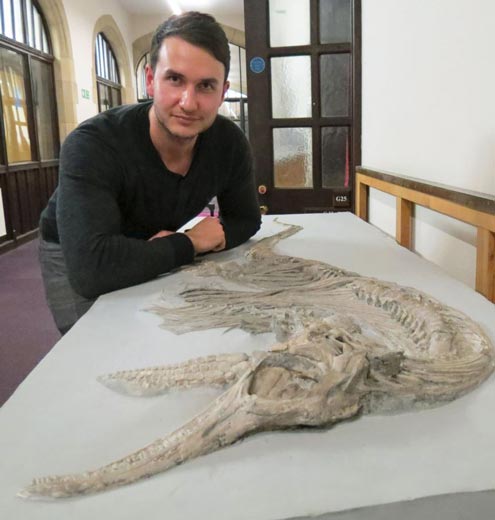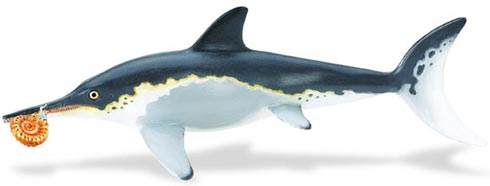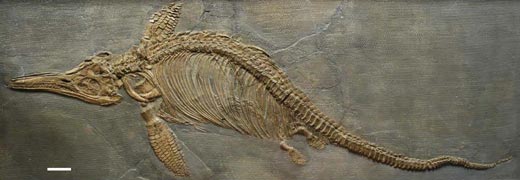Two New Species of British Ichthyosaur Swim into View
Two New Species of Jurassic Ichthyosaur Described After Six Years of Research
Much has been written about the “bone wars”, the rivalry between two distinguished and very eminent pioneering American palaeontologists Charles Othniel Marsh and Edward Drinker Cope as they competed with each other to excavate and describe the fossilised bones of dinosaurs from the western United States. However, during Georgian and Victorian times in Britain, a race was on between well-to-do landowners to excavate and put on display a myriad of strange antediluvian creatures, the remains of which were being found in quarries and construction sites as the industrial revolution transformed the countryside.
Thanks to some dogged detective work, palaeontologists Dean Lomax (Honorary Scientist at The University of Manchester) and Professor Judy Massare (Brockport College, New York) have identified two new species of ichthyosaur (fish-lizard), from fossil material excavated more than 150 years ago. These two, very modern scientists are helping to write a new chapter on the evolution, radiation and diversification of British ichthyosaurs, a story that links back to the early pioneers of palaeontology.
Palaeontologist Dean Lomax Peruses an Ichthyosaur Specimen

Palaeontologist Dean Lomax with one of the Ichthyosaur specimens from the study, BRSUG 25300, the holotype specimen of Ichthyosaurus larkini.
Picture credit: University of Manchester
Britain During the Jurassic
For much of the Jurassic, the area now known as the British Isles was covered by a warm, tropical sea. Scattered across this seascape were a number of small islands, this area superficially resembled the Caribbean of today, but instead of green iguanas, basilisk lizards, wild pigs and capuchin monkeys typical of islands such as Barbados, Puerto Rico and Grenada, the terrestrial landscape back in the Jurassic was dominated by dinosaurs.
For further information on the different types of dinosaur that once thrived on the landmass now known as the British Isles we recommend “Dinosaurs of the British Isles” by Dean Lomax and Nobumichi Tamura, available from Siri Scientific Press: Dinosaurs of the British Isles can be ordered here. The marine environment was also home to an array of exotic prehistoric animals and amongst the most successful of the Early Jurassic marine reptiles were the ichthyosaurs, formidable predators that had streamlined bodies similar to those of modern dolphins.
An Illustration of a Typical Ichthyosaurus
Picture credit: Everything Dinosaur
Tracking Down Ichthyosaurs
Many of the specimens excavated by early palaeontology pioneers on behalf of wealthy landowners and benefactors were poorly documented, several specimens have become lost, whilst a significant proportion have not been studied fully. Dean and Judy set about tracking down examples of British ichthyosaurs, no mean feat as over the years, many fossils had been acquired by museums from all over the world and a considerable amount of ichthyosaur material that originated from the British Isles is housed in Europe and elsewhere. After six years of research, examining hundreds of fossils from all over the UK, Europe and North America, the intrepid pair have been able to identify two new species of British marine reptile.
For models and replicas of marine reptiles including ichthyosaurs: Marine Reptile Models and Figures.
Analysing Anatomical Features – Hiding in Plain Sight
By analysing features in the skull and post-cranial material, the scientists were able to identify a new species of Ichthyosaurus from a specimen at the University of Bristol. This almost complete skeleton, had been on public display in the School of Earth Sciences for many years and thanks to Dean and Judy, this specimen has been identified as a new species of Early Jurassic ichthyosaur. The animal has been named Ichthyosaurus larkini. The species honours British palaeontologist Nigel Larkin. The name ‘Larkin’ means “fierce”, which is quite fitting for what was a fast moving, nektonic predator!
Commenting on the outcome of this research, Dean Lomax stated:
“It’s quite amazing, hundreds of people must walk past this skeleton every day, yet its secrets have only just been uncovered. This specimen has received little in the way of scientific study, although this is not uncommon as there is so much material to see and only a finite amount of funding to see and study everything – in fact, much of my research is self-funded”.
A View of the Holotype Specimen of Ichthyosaurus larkini
Picture credit: University of Manchester
Visit the website of Dr Dean Lomax: Palaeontologist Dr Dean Lomax.
The Second Species – Ichthyosaurus somersetensis
The second new species to be described, making a total of six species within the Ichthyosaurus genus, has an equally interesting story. The key specimen was probably collected from a quarry in Glastonbury, Somerset, sometime in the 1840s. It was sent to Delaware in the United States by Edward Wilson of Tenby, South Wales, for his brother, Dr Thomas Wilson, who donated the specimen to Philadelphia’s Academy of Natural Sciences in 1847. The fossil has remained within the Academy’s vertebrate fossil collection ever since. It was kept in storage and few people knew that it even existed.
Dean explained:
“In my opinion, this specimen is the best example of Ichthyosaurus collected to date. It paints such a cool picture too, having been found in a quarry in the Somerset countryside, cleaned, and then sent by boat to Philadelphia, and only now for it to be rediscovered – it’s like a good mystery book, piecing the story together!”
As so many Ichthyosaurus specimens have been found in Somerset, it was decided to honour the south-west of England county by naming the new species Ichthyosaurus somersetensis.
The Holotype Specimen of Ichthyosaurus somersetensis
Picture credit: E. Daeschler Academy of Sciences of Drexel University.
Another British Ichthyosaur
The picture above shows the holotype specimen of Ichthyosaurus somersetensis a practically complete skeleton lying on its right side; from Glastonbury, near Street, Somerset, the white scale bar represents 10 cm.
As part of their extensive search, Dean and Judy were keen to visit collections that were not known for their marine reptile fossils, which meant other scientists may not have visited them previously. All examples of the new species come from locations that can no longer be accessed, for example, old quarries.
Dean concluded by saying:
“It is our hope that other similar fossils will be rediscovered in uninspected collections and brought to the attention of palaeontologists. Who knows what else is waiting to be (re)discovered?”
To read an article about the naming of a new species of marine reptile to honour Mary Anning: New Species of Ichthyosaurus honours Mary Anning.
The Paper (published in Palaeontology): Two New Species of Ichthyosaurus from the Lowermost Jurassic (Hettangian) of Somerset, England by Dean R. Lomax and Judy A. Massare.
Visit Everything Dinosaur’s website: Everything Dinosaur.




